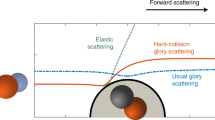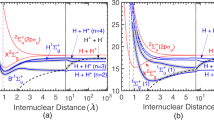Abstract
Extensive theoretical1,2,3,4,5,6,7,8,9,10,11,12,13 and experimental2,13,14,15,16,17,18,19,20,21,22 studies have shown the hydrogen exchange reaction H + H2 → H2 + H to occur predominantly through a ‘direct recoil’ mechanism: the H–H bonds break and form concertedly while the system passes straight over a collinear transition state, with recoil from the collision causing the H2 product molecules to scatter backward. Theoretical predictions agree well with experimental observations of this scattering process15,16,17,18,19,20,22. Indirect exchange mechanisms involving H3 intermediates have been suggested to occur as well8,9,10,11,12,13, but these are difficult to test because bimolecular reactions cannot be studied by the femtosecond spectroscopies23 used to monitor unimolecular reactions. Moreover, full quantum simulations of the time evolution of bimolecular reactions have not been performed. For the isotopic variant of the hydrogen exchange reaction, H + D2 → HD + D, forward scattering features21 observed in the product angular distribution have been attributed21,12 to possible scattering resonances associated with a quasibound collision complex. Here we extend these measurements to a wide range of collision energies and interpret the results using a full time-dependent quantum simulation of the reaction, thus showing that two different reaction mechanisms modulate the measured product angular distribution features. One of the mechanisms is direct and leads to backward scattering, the other is indirect and leads to forward scattering after a delay of about 25 femtoseconds.
This is a preview of subscription content, access via your institution
Access options
Subscribe to this journal
Receive 51 print issues and online access
$199.00 per year
only $3.90 per issue
Buy this article
- Purchase on Springer Link
- Instant access to full article PDF
Prices may be subject to local taxes which are calculated during checkout



Similar content being viewed by others
References
Hirshfelder, J. O., Eyring, H. & Topley, B. Reactions involving hydrogen molecules and atoms. J. Chem. Phys. 4, 170–177 (1936).
Truhlar, D. G. & Wyatt, R. E. History of H3 kinetics. Annu. Rev. Phys. Chem. 27, 1–43 (1976).
Neuhauser, D. et al. State-to-state rates for the D + H2(v = 1,j = 1) → HD(v′,j′) + H reaction–predictions and measurements. Science 257, 519–522 (1992).
Boothroyd, A. I., Keogh, W. J., Martin, P. G. & Peterson, M. R. A refined H3 potential surface. J. Chem. Phys. 104, 7139–7152 (1996).
Zhang, J. Z. H. & Miller, W. H. Quantum reactive scattering via the S-matrix version of the Kohn variational principle: integral cross sections for H + H2(v1 = j1 = 0) → H2(v2 = 1,j2 = 1,3) + H in the energy range Etotal = 0.9-1.4 eV. Chem. Phys. Lett. 153, 465–470 (1988).
Miller, W. H. Recent advances in quantum mechanical reactive scattering theory. Annu. Rev. Phys. Chem. 41, 245–281 (1990).
D'Mello, M., Manolopoulos, D. E. & Wyatt, R. E. Quantum dynamics of the H + D2 → D + HD reaction: comparison with experiment. J. Chem. Phys. 94, 5985–5993 (1991).
Aoiz, F. J., Herrero, V. J. & Sáez Rábanos, V. Quasiclassical state to state reaction cross sections for D + H2(v = 0,j = 0) → HD(v′,j′) + H. Formation and characteristics of short-lived collision complexes. J. Chem. Phys. 97, 7423–7436 (1992).
Miller, W. H. & Zhang, J. Z. H. How to observe the elusive resonances in H or D + H2 → H2 or HD + H reactive scattering. J. Phys. Chem. 95, 12–19 (1991).
Schatz, G. C. & Kuppermann, A. Dynamical resonances in collinear, coplanar, and three-dimensional quantum mechanical reactive scattering. Phys. Rev. Lett. 35, 1266–1269 (1973).
Skodje, R. T., Sadeghi, R., Köppel, H. & Krause, J. L. Spectral quantization of transition state dynamics for the three-dimensional H + H2 reaction. J. Chem. Phys. 101, 1725–1729 (1994).
Allison, T. C., Friedman, R. S., Kaufman, D. J. & Truhlar, D. G. Analysis of the resonance in H + D2 → HD(v′ = 3) + D. Chem. Phys. Lett. 327, 439–445 (2000).
Fernández-Alonso, F. & Zare, R. N. Scattering resonances in the simplest chemical reaction. Annu. Rev. Phys. Chem. 53, 67–99 (2002).
Nieh, J.-C. & Valentini, J. J. Experimental observation of dynamical resonances in the H + H2 reaction. Phys. Rev. Lett. 60, 519–522 (1988).
Schnieder, L., Seekamp-Rahn, K., Wrede, E. & Welge, K. H. Experimental determination of quantum state resolved differential cross sections for the hydrogen exchange reaction H + D2 → HD + D. J. Chem. Phys. 107, 6175–6195 (1997).
Wrede, E. et al. The dynamics of the hydrogen exchange reaction at 2.20 eV collision energy: comparison of experimental and theoretical differential cross sections. J. Chem. Phys. 110, 9971–9981 (1999).
Fernández-Alonso, F., Bean, B. D. & Zare, R. N. Differential cross sections for H + D2 → HD(v′ = 1,J′ = 1,5,8) + D at 1.7 eV. J. Chem. Phys. 111, 1035–1042 (1999).
Fernández-Alonso, F., Bean, B. D. & Zare, R. N. Differential cross sections for H + D2 → HD(v′ = 2,J′ = 0,3,5) + D at 1.55 eV. J. Chem. Phys. 111, 2490–2498 (1999).
Liu, K. Crossed-beam studies of neutral reactions: state-specific differential cross sections. Annu. Rev. Phys. Chem. 52, 139–164 (2001).
Casavecchia, P. Chemical reaction dynamics with molecular beams. Rep. Prog. Phys. 63, 355–414 (2000).
Fernández-Alonso, F. et al. Evidence for scattering resonances in the H + D2 reaction. Angew. Chem. Int. Edn Engl. 39, 2748–2752 (2000).
Fernández-Alonso, F. et al. Forward scattering in the H + D2 → HD + D reaction: comparison between experiment and theoretical predictions. J. Chem. Phys. 115, 4534–4545 (2001).
Zewail, A. H. Femtochemistry: atomic-scale dynamics of the chemical bond. J. Phys. Chem. 104, 5660–5694 (2000).
Rinnen, K.-D., Buntine, M. A., Kliner, D. A. V., Zare, R. N. & Huo, W. M. Quantitative determination of H2, HD, and D2 internal-state distributions by (2+1) resonance-enhanced multiphoton ionization. J. Chem. Phys. 95, 214–225 (1991).
Althorpe, S. C. Quantum wavepacket method for state-to-state reactive cross sections. J. Chem. Phys. 114, 1601–1616 (2001).
Skouteris, D., Castillo, J. F. & Manolopoulos, D. E. ABC: a quantum reactive scattering program. Comput. Phys. Commun. 133, 128–135 (2000).
Althorpe, S. C., Kouri, D. J. & Hoffman, D. K. Further partitioning of the reactant-product decoupling equations of state-to-state reactive scattering and their solution by the time-independent wavepacket method. J. Chem. Phys. 107, 7816–7824 (1997).
Judson, R. S., Kouri, D. J., Neuhauser, D. & Baer, M. Time-dependent wavepacket method for the complete determination of S-matrix elements for reactive molecular collisions in 3 dimensions. Phys. Rev. A 42, 351–366 (1990).
Balint-Kurti, G. G., González, A. I., Goldfield, E. M. & Gray, S. K. Quantum reactive scattering of O(1D) + H2 and O(1D) + HD. Faraday Discuss. 110, 169–183 (1998).
Huang, Y., Zhu, W., Kouri, D. J. & Hoffman, D. K. Distributed approximating function approach to atom-diatom reactive scattering: Time-dependent and time-independent wavepacket treatments. J. Phys. Chem. 98, 1868–1874 (1994).
Acknowledgements
We thank L. Bañares and J. F. Castillo for discussions on the H + D2 reaction, and D. C. Clary, D. E. Manolopoulos and J. M. Hutson for reading the manuscript. S.C.A. thanks the Royal Society for a University Research Fellowship. F.F.A. acknowledges partial support by a European Union Marie Curie fellowship. The experimental part of this work was supported at Stanford by the US National Science Foundation.
Author information
Authors and Affiliations
Corresponding author
Ethics declarations
Competing interests
The authors declare no competing financial interests.
Rights and permissions
About this article
Cite this article
Althorpe, S., Fernández-Alonso, F., Bean, B. et al. Observation and interpretation of a time-delayed mechanism in the hydrogen exchange reaction. Nature 416, 67–70 (2002). https://doi.org/10.1038/416067a
Received:
Accepted:
Issue Date:
DOI: https://doi.org/10.1038/416067a
This article is cited by
-
Observation of the geometric phase effect in the H+HD→H2+D reaction below the conical intersection
Nature Communications (2020)
-
Direct observation of forward-scattering oscillations in the H+HD→H2+D reaction
Nature Chemistry (2018)
-
OH electron, where art thou?
Nature Chemistry (2013)
-
When molecules don't rebound
Nature (2008)
-
Vibrational excitation through tug-of-war inelastic collisions
Nature (2008)
Comments
By submitting a comment you agree to abide by our Terms and Community Guidelines. If you find something abusive or that does not comply with our terms or guidelines please flag it as inappropriate.



